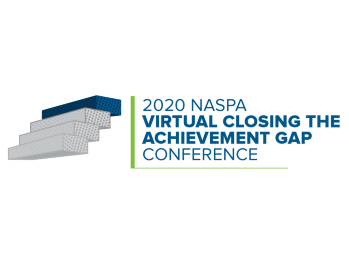
NASPA Closing the Achievement Gap Conference
Workshop Student Success Equity, Inclusion, and Social Justice Division
June 29 - July 1, 2020 Virtual
Presented By

About
The NASPA Closing the Achievement Gap Conference provides an avenue for thought leaders and practitioners to share ideas, strategies, and evidence based research on ways to dismantle barriers related to student success. The Conference explores the various factors woven into students’ experiences which may impact their success and completion. Through dynamic keynote speakers and panels, thought-provoking concurrent sessions, and engaging networking opportunities, NASPA’s Closing the Achievement Gap Conference is your exclusive opportunity to engage with colleagues committed to student completion.
For more information on the 2020 NASPA Virtual Conferences on Student Success in Higher Education, please visit this website.
Learning Outcomes and Themes
Understanding Intersectionality and Equity in Higher Education
- Participants will be able to articulate how equity and inclusion intersect with the experiences of underrepresented and marginalized students.
- Participants will identify institutional barriers that disproportionately impact these student populations.
Strategies for Systemic Change and Marginalized Student Support
-
Participants will learn to apply evidence-based strategies to design programs and initiatives that address systemic inequities and promote success for marginalized students, including first-generation populations.
-
Participants will develop frameworks for creating inclusive programs that integrate social justice principles and equitable access.
Advancing Leadership and Collaboration for Equity
-
Participants will gain practical tools to lead institutional change initiatives, advocate for equitable policies, and engage stakeholders in collaborative efforts to dismantle systemic barriers.
-
Participants will acquire techniques for assessing and evaluating the effectiveness of equity-focused programs and making data-informed decisions.